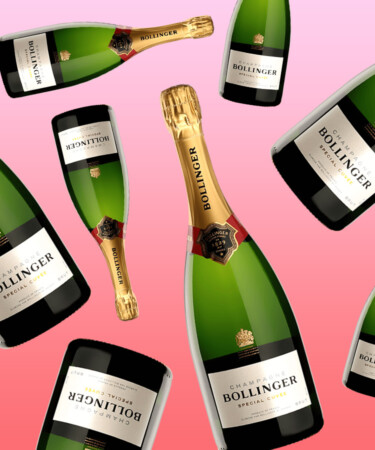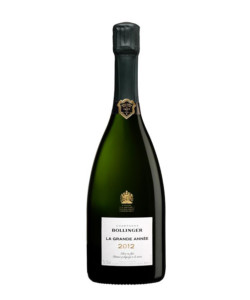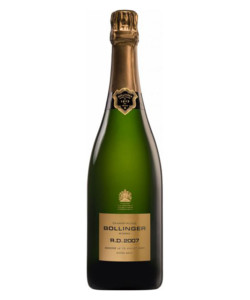Of the hundreds of maisons in France, few have the means to continue producing Champagne the way it was made centuries ago. Of those estates is Bollinger — or Bolly, as it is more commonly known in the United Kingdom — an estate dating back to 1829. Today, Bollinger is one of the only remaining independent Champagne houses.
Known for its Pinot Noir-driven blends, Bollinger always goes the extra mile, aging each of its Champagnes for double, triple, and even quadruple the amount of time necessitated by the appellation’s requirements. Implementing increased aging times and almost obsolete production methods, Bollinger produces Champagnes that stand out among the multitude of producers in its home region.
From its aristocratic origins to its modern popularity among the British, here are 15 things you should know about Bollinger Champagne.
The Champagne House was founded by a member of the French aristocracy.
Though the Bollinger name hails from the Bollinger family, the origins of the beloved house begin with a member of the French aristocracy, Anthanse de Villermont, who inherited an estate in Aÿ-Champagne from his sister. Recognizing the success that could come from Champagne production on the estate, he quickly set out to establish the estate as a grower and producer of the wine. However, as a member of the aristocracy, Villermont was forbidden by law from engaging in any commercial activity, meaning he was not allowed to market or sell his Champagnes himself. Thus, he requested assistance from Joseph “Jacques” Bollinger, a specialist in Champagne sales, and Paul Renaudin, a Champagne native, who became co-founders of the estate. On Feb. 6, 1829, the company Renaudin-Bollinger & Cie was founded with Bollinger in charge of sales and Renaudin responsible for the cellar. Bollinger soon became the house’s primary figurehead.
A number of difficulties threatened the house’s security early on.
In 1899, shortly after Georges Bollinger — son of Joseph — took over as head of the Champagne house in succession to his brother (also named Joseph), a number of challenges emerged. Almost immediately, Georges was responsible for tending to the vineyards during Champagne’s phylloxera outbreak, which required almost every single vineyard to be uprooted and replanted. Phylloxera, an insect native to North America, attaches to vines and kills Vitis vinifera (wine grapes) one plot at a time. To preserve the house’s winemaking capabilities, every plot, with very few exceptions, was required to be replanted with American rootstocks, which were resistant to phylloxera — a process that took over two decades to complete.
At the tail end of tending to the phylloxera crisis, the Great War further threatened the sanctity of Bollinger and the Champagne region as a whole. Over the course of the conflict, Champagne was the location of two large-scale offensives to halt German forces, which wreaked havoc on the landscape with cellars being looted and vineyards damaged from onslaughts of bullets. Georges, steadfast in his love for Bollinger, protected the cellar from looters on a number of occasions but unfortunately passed away in 1918, just months before the end of the war.
World War II forced the Champagne house to get crafty.
When Jacques Bollinger, son of Georges, passed away at the age of 42, the Bollinger House was left to his widow, Elisabeth (Lily) Bollinger, who took over management of the estate until her death in 1971. Having taken over in 1941, Lily was faced with the difficult task of running the Champagne house while living under Nazi occupation. With all houses under Nazi occupation, Lily attempted to protect her livelihood by sneakily handing off bottles of Champagne to Nazi soldiers in order to prevent them from looting her cellars. One story even alleges that when Otto Klaebisch — the German “Weinfuhrer” put in charge of the Champagne region — visited Champagne Bollinger, Madame Bollinger intentionally sat him in a chair that was much too small after politely welcoming him into her home. Rather than sitting uncomfortably, the Nazi stood the entire visit and never returned to the Bollinger house in the future.
It once served as a place of refuge during German bombings.
With France under siege of the Nazi forces, Madame Bollinger was committed to doing as much as possible to assist the community. In August 1944, after a devastating bombing that destroyed much of Aÿ, Lily turned the Bollinger house into a refuge for the town’s inhabitants. She even made the funeral arrangements for victims of the disastrous bombing.
Madame Bollinger was once nicknamed the “First Lady of France.”
Following the conclusion of World War II, Lily Bollinger set out on a mission to bring her Champagnes to the rest of the world. For the next 25 years, she traveled tirelessly across North America and the United Kingdom, meeting day after day with journalists and suppliers and hosting tastings. Of her own Champagnes, Madame Bollinger famously told the London Daily Mail, “I drink it when I’m happy and when I’m sad. Sometimes I drink it when I’m alone. When I have company I consider it obligatory. I trifle with it if I’m not hungry and drink it when I am. Otherwise I never touch it — unless I’m thirsty.” She was able to build such extensive relationships across the Channel and pond that she earned herself the nickname “First Lady of France” from the Chicago American in 1961.
There’s a Bollinger expression developed by Lily Bollinger herself.
In 1963, Bollinger released a new Champagne developed by Madame Bollinger herself — Bollinger R.D. Extra Brut — with the initials R.D. meaning “recently disgorged.” The wine combined modern farming techniques and traditional Champenois methods with the idea of competing with prestige cuvée releases from other houses. Bollinger R.D. was developed by dosing much older vintages — the first release was a vintage from 1947 — like extra bruts by disgorging them by hand. In by-hand disgorgement, sediment is very gently pushed to the neck of the bottle, ensuring lasting vibrancy in old vintages that otherwise may not taste as fresh. Bollinger R.D. Champagnes stand out from a number of other wines from the region due to their extensive aging period, four times longer than the regulated minimum.
Bollinger is home to two of the only vineyards unmarred by phylloxera.
During her time as head of Bollinger, Lily was able to identify two vineyards on the estate that remained unscathed from the wrath of phylloxera — the only two such plots remaining in Champagne. It was at these vineyards, Clos Saint-Jacques and Clos Chaudes-Terres, that she developed the first French old-vine cuvée, Vieilles Vignes Françaises. As a means of preserving traditional Champagne production, vines in each of these vineyards are farmed using provignage, an otherwise obsolete layering method used to preserve characteristics of grapes by multiplying buried shoots. Once fermented, they are then riddled and disgorged by hand, ensuring the wines are vivacious and a true celebration of Champagnes now otherwise lost to history.
Bollinger uses an almost-extinct aging method.
Where most Champagne houses have abandoned traditional aging methods in favor of more economical stainless steel vats, Bollinger remains true to its heritage and continues to age its wines in oak barrels. Over 4,000 barrels call Bollinger home — some over 100 years old — all of which are sourced from Burgundy, where they were once used to age Chardonnay. As oak is an ever-changing substance, it plays a crucial role in the aging of Bollinger Champagnes as the wines are able to experience slight, yet persistent, oxygenation, which softens their tannic edge and adds a slightly sweet aromatic complexity that cannot be achieved using steel vat aging. Of the numerous houses in Champagne today, Bollinger is one of just two — Krug being the other — that continue to use oak barrel aging.
Each year, some of the finest wines are kept in reserve and bottled as magnums.
It is a common practice for winemakers to hold back a selection of their finest creations each year as reserves. Uncommon, however, is the idea of bottling these reserves in magnums, and leaving them on cellar shelves to continue aging. Though uncommon, this idea has been in practice at Bollinger since 1892. Further separating Bollinger’s reserve methods from other houses’ is the slight second fermentation its wines undergo before they are bottled and corked, which stabilizes aromas of each vintage before they are added to the collection of over 800,000 magnums in Bollinger’s cellar. These vintages, some of which have aged for 12 or more years, are then blended into the house’s Special Cuvée release.
Bollinger Champagnes are a celebration of Pinot Noir.
Bollinger wines are known for their unusually high percentage of Pinot Noir. Despite Pinot Noir grapes only making up about 38 percent of the total grapes grown in the region, the variety makes up approximately 60 percent of Bollinger’s blends. Pinot Noir accounts for 60 percent of the vines planted at Champagne Bollinger, the same percentage of which is used in the house’s Special Cuvée release. Of the Champagne house’s five key principles, Pinot Noir is a top priority, with management of vineyards, magnums of reserve wines, oak barrels, and time rounding out the list.
The house remains steadfast in its commitment to sustainability.
Since its inception, Bollinger has been committed to sustainability and responsible farming. In 2012, the house was the first in France to be certified as “High Environmental Value.” Two years later, it made history again by becoming the first to receive a certification in sustainable viticulture in Champagne. Further, the house is committed to reducing its carbon footprint with goals in place to improve biodiversity by increasing land dedicated to nature by 40 percent by 2029. Additionally, Bollinger also hopes to be using 100 percent recycled and recyclable packaging by 2029 in addition to reducing glass weight by 7 percent and reducing gas emissions by 40 percent. It is on track to achieve carbon neutrality by 2029.
Champagne isn’t Bollinger’s only specialty.
Though most renowned for its achievements in Champagne production, Bollinger also produces one wine that’s not sparkling — La Côte aux Enfants, a 100 percent Pinot Noir. Made in the Burgundian style, the single varietal is produced using whole-cluster vinification, a method in which the grapes are fermented in steel vats without any crushing or stem removal. Aged in very small oak barrels, La Côte aux Enfants is produced in very select quantities and only when harvesters have deemed crop selections to be of excellent quality.
In 2010, a fully stocked, abandoned wine cellar was discovered at the house.
Just over a decade ago, when an intern at Champagne Bollinger was sent into the cellar to catalog and clean, they stumbled upon a shocking discovery. Behind a wall of empty bottles that were removed for cleaning, a sealed wall was uncovered that, when knocked down, revealed 600 bottles of magnum reserve wines and wine collections of the Bollinger family dating back to 1830. Shortly thereafter, the vintages were restored and are now displayed in two wine libraries at the estate, Galerie 1829 and La Réserve.
Bollinger is an official supplier to Buckingham Palace.
Just five decades after Bollinger released its first Champagnes, the wine began garnering favor among British royalty. In 1884, the house received a royal warrant from Queen Victoria indicating that the Champagne was a regularly supplied good for the royal family. Later on, in 1950, with the tireless work being done by Madame Bollinger, a royal warrant was granted to the house again by King George VI. The royal stamp of approval to this day remains proudly displayed on every bottle of Bollinger. In addition to being the official supplier of Buckingham Palace, Bollinger is also a sponsor of the Oxford and Cambridge Boat Race, the Royal Ascot, and the England rugby team. Today, Bollinger is so popular among the Brits — the country imports nearly 1,250,000 bottles per year, almost half of Bollinger’s annual supply — that it is more recognizable by its colloquial name, Bolly.
It has James Bond’s stamp of approval.
Not only has Bollinger garnered the fancy of British royals, but it’s received approval from famous fictional Brits including 007 himself. Though perhaps more synonymous with his Vesper Martini — shaken, not stirred — in the original novels written by Ian Fleming, Bond is a known Bollinger enthusiast. The wine appears in 14 Bond films including 1973’s “Live and Let Die,” when the spy asks for a bottle when entering a hotel, and 1985’s “A View to Kill,” when he clarifies his favorite Bollinger vintage, 1975. In celebration of four decades as the “Official Champagne of 007,” Bollinger released Bollinger Special Cuvée 007 Limited Edition for the 2021 film “No Time To Die.”


